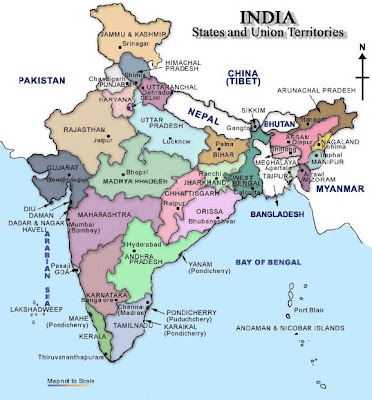Thursday, December 23, 2010
When will states get due respect?
At the stroke of midnight on august 15th 1947, british relinquished India. Despite the jubilation, deep within was a country deeply divided. The british policy of promoting sub national identities to keep a check on growing nationalism left a deep scar on Indian society. Independent India was characterised by a stagnant economy with large spread regional disparity.
Economic growth was seen only in and around Delhi, Kolkatta and Mumbai. This was because of the British administration’s trade policy, land tenure system and selective public investment. Hence one of key objectives of independent idea was to bridge the disparities. Since then all five year plans have focused on bringing about balanced regional development .
Till the 4th five year plan India followed a strategy of
i) Priority to agriculture, irrigation, community development and other activities which could stimulate rural economy
ii) Equitable development of infrastructure
iii) Establishment of new enterprises with a focus on addressing regional disparity
All these were long term goals and their results could only be seen only after a decade. In the short term government increased its public expenditure. But this expenditure was concentrated on development of non agriculture sector. The government followed a policy of non intervention with respect to agriculture sector while on the other hand it played the rôle of facilitator in non agriculture sector.
This policy resulted India development of new urban centers around the enterprises and industrial clusters. The repercussions of neglecting agriculture sector came to the fore in 1960s when there was an acute shortage of food. This forced the government to focus on agriculture development which lead to the green revolution. Green revolution supposedly transformed India from a ship to mouth nation into a food surplus country. This is a flawed analysis. What green revolution did was , it concentrated on areas that
A) already had substantial agriculture and irrigation facilities
B) was free form zamindari system
This was the reason why the impact of green revolution was felt mostly in the northwest India. Green revolution never made India a self sufficient country. Its aim was only to provide food to all those who could buy but not food for all. This is the reason why we still have over 30% people struggling for even a square meal a day.
Following the green revolution, another major turn around in India’s sojourn was the liberalisation in 1990s. It was projected as a leap for India’s economy and its benefits would percolate to all sections and regions of society and thereby reduce disparity. On the contrary it widened the disparity and increased competition within the state. The growth of myriad regional parties bears testimony to the fact that people had become restless with the elitist policies of central government. The rich states got richer while poor states became poorer. The rich states with their surplus were able to provide incentives to private investors and hence reaped the benefits of liberalisation.
This indicates a clear dominance of central government in economic policy making. This has widened the disparity. This disparity may soon threaten the federal structure of our nation. It is high time that central government starts respecting federalism and give states the due respect.
Subscribe to:
Post Comments (Atom)


No comments:
Post a Comment